Bulbs
Flower Basics
Flower Beds & Specialty Gardens
Flower Garden
Garden Furniture
Garden Gnomes
Garden Seeds
Garden Sheds
Garden Statues
Garden Tools & Supplies
Gardening Basics
Green & Organic
Groundcovers & Vines
Growing Annuals
Growing Basil
Growing Beans
Growing Berries
Growing Blueberries
Growing Cactus
Growing Corn
Growing Cotton
Growing Edibles
Growing Flowers
Growing Garlic
Growing Grapes
Growing Grass
Growing Herbs
Growing Jasmine
Growing Mint
Growing Mushrooms
Orchids
Growing Peanuts
Growing Perennials
Growing Plants
Growing Rosemary
Growing Roses
Growing Strawberries
Growing Sunflowers
Growing Thyme
Growing Tomatoes
Growing Tulips
Growing Vegetables
Herb Basics
Herb Garden
Indoor Growing
Landscaping Basics
Landscaping Patios
Landscaping Plants
Landscaping Shrubs
Landscaping Trees
Landscaping Walks & Pathways
Lawn Basics
Lawn Maintenance
Lawn Mowers
Lawn Ornaments
Lawn Planting
Lawn Tools
Outdoor Growing
Overall Landscape Planning
Pests, Weeds & Problems
Plant Basics
Rock Garden
Rose Garden
Shrubs
Soil
Specialty Gardens
Trees
Vegetable Garden
Yard Maintenance
How to Get Rid of Gnats on an Orchid Plant
How to Get Rid of Gnats on an Orchid Plant. Orchids grow in a wide range of environments throughout U.S. Department of Agriculture plant hardiness zones 2 through 12, and fungus gnats typically aren't a problem for those growing in regular garden soil. The tiny, black flying insects prefer orchids growing in wet, overfertilized potting soil. They...

Orchids grow in a wide range of environments throughout U.S. Department of Agriculture plant hardiness zones 2 through 12, and fungus gnats typically aren't a problem for those growing in regular garden soil. The tiny, black flying insects prefer orchids growing in wet, overfertilized potting soil. They lay eggs on the fungus decaying the wet potting mix. The fungus, in turn, feeds developing gnat larvae. To rid an orchid of fungus gnats, eliminate the larvae, and adjust the plant's watering and fertilizer schedules.
Bug-Killing Bacteria
The commercially available bacteria Bacillus thuringiensis var. israelensis starves gnat larvae by paralyzing their digestive tracts. Sprinkle enough ready-to-use, granulated Bti over the orchid's potting soil to cover it, and water it in. Apply weekly for two more weeks, or as often as the label recommends. If the gnats return, repeat the process.
To prevent skin, eye and lung irritation, dress in a long-sleeved shirt, long pants, waterproof gloves, safety goggles and a respiratory mask while working with the granules.
Gnat-Nibbling Nematodes
Parasitic Steinernema feltiae nematodes burrow into and feed on fungus gnat larvae, releasing lethally toxic bacteria in the process. When their hosts die after three or four days, the nematodes move on to new ones.
To apply nematodes, set the orchid out of direct sun and water it well. Sprinkle the nematode-containing carrier -- usually vermiculite -- over the surface of the potting soil. Water again, but not heavily enough to wash the carrier out of the pot. Use the amount of carrier the label recommends for the orchid pot's size; 20,000 nematodes for a 12-inch pot is typical.
Predatory Mites
Predatory Hypoaspsis miles mites feed on larvae and eggs in the top 1/2 inch of potting mix. Each devours up to five larvae per day. After clearing an infestation, they survive on plant debris.
Mite packaging contains enough food to sustain the predators for up to two weeks. Before applying the mites, water the orchid and let it stand for 10 minutes. Shake enough carrier from the container to cover the potting mix. Store the remainder for no more than two weeks at 45 to 65 degrees Fahrenheit.
Cultural Gnat Control
To stop fungus gnats from laying eggs, repot an orchid frequently in slowly decaying potting mix. Good choices contain coconut fiber, charcoal or inorganic perlite. Always use a pot with drainage holes.
Check the potting mix regularly, and water only when the top 1 inch feels dry to the touch. Never fertilize more heavily or frequently than your fertilizer brand recommends for a specific orchid. Fertilizer nitrogen feeds soil-decaying fungi that lure adult gnats.
Chemical insecticide sprays only kill the adult gnats present when the orchid is treated. Because they don't harm larvae, they're considered a short-term solution.